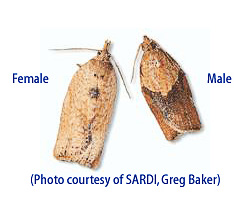Light Brown Apple Moth Pest Profile


Description
Adults are light brown, yellowish moths with varying amounts of darker brown, with a wingspan of 16–25 mm (Fig. 1). Females are larger than males, and usually have less distinct markings, but often have a distinct spot in the middle when the wings are closed. Eggs are pale white and deposited slightly overlapping each other in groups of 20–50. Larvae are green, about 18 mm long at maturity. They are superficially similar to other native tortricid larvae and DNA analysis is necessary to confirm their identity. Pupae are brown, about 11 mm long.
Background
This moth is originally from Australia, and has become established in New Zealand, New Caledonia, Hawaii and the British Isles. Its discovery in California is a new record for the Americas.
Host
LBAM has been associated with many plants representing 290 genera (USDA 2008). These genera contain over 2000 species and many of these species that are not already known to be hosts could prove to be hosts as LBAM becomes exposed to them. Some notable trees recorded as hosts are apple, pear, peach, apricot, nectarine, citrus, persimmon, cherry, almond, avocado, oak, willow, walnut, poplar, cottonwood, Monterey pine and eucalyptus. Some common shrub and herbaceous hosts are grape, kiwifruit, strawberry, berries (blackberry, blueberry, boysenberry, and raspberry), corn, pepper, tomato, pumpkin, beans, cabbage, carrot, alfalfa, rose, camellia, pittosporum, jasmine, chrysanthemum, clover, lupine and plantain.
Life Cycle and Damage
Development is continuous, with no true dormancy (Venette et al. 2003). In Australia, this moth typically has three generations per year and over–winters as a larva. Life cycle projections for the areas of California where it has been found indicate that four to five generations are possible. Females deposit egg masses containing 20–50 eggs on the upper leaf surface or on fruit. Fecundity varies considerably and females are capable of laying up to 1496 eggs in their lifetime, but the average has been recorded variously as 118 to 462. Larvae disperse and construct silken shelters on the underside of leaves, usually near a midrib or large vein. Older larvae roll together leaves and buds or fruit with webbing. Damage to fruit occurs as surface feeding by the larvae. Larvae will occasionally enter the fruit to feed. Pupation takes place within the larval nests.
Survey Methods
There is a pheromone lure for the males, namely a 95:5 mixture of (E)–11–Tetradecenyl acetate: (E,E)–9,11–Tetradecadienyl acetate, that can be used in sticky traps.
Management
Mating disruption, parasitoids and various insecticides have been used to control LBAM elsewhere.
Distribution
The following thirteen counties are considered to have one or more infested areas and are therefore regulated: Alameda, Contra Costa, Marin, Monterey, Napa, San Benito, San Francisco, San Mateo, Santa Barbara, Santa Clara, Santa Cruz, Solano and Sonoma.
Economic Impact
The impact on production costs for LBAM hosts could top $100 million. It was estimated for Australia that LBAM causes AU$21.1 million annually in lost production and control costs, or about 1.3% of gross fruit value: for apples, pears, oranges and grapes (Sutherst 2000). Applying this percentage to the 2005 gross value of these same crops in California of $5.4 billion (USDA NASS 2006), the estimated annual production costs would be $70.2 million. This estimate does not include economic costs to the nursery industry nor to other significant host crops in California, such as apricots, avocados, kiwifruit, peaches and strawberries. If the same level of costs were incurred by these as for the previous four crops, the additional costs would be $63.1 million, based on their 2005 gross value of $4.8 billion. Therefore, the total lost production and control costs in California could be $133 million for all of the crops mentioned above.
Exact economic impacts on international and domestic exports are uncertain at this time. California is the nation’s leader in agricultural exports and in 2003 shipped more than $7.2 billion in both food and agricultural commodities around the world (CASS 2004). Some countries have specific regulations against this pest and many others consider it a regulated pest that would not be knowingly allowed to enter. Additional measures, such as preharvest treatments and postharvest disinfestation, would likely have to be taken to ensure that shipments to these countries are free from LBAM. In addition, LBAM is an invasive pest; i.e., it is not established in the continental United States and, therefore, other states within the U.S. would likely impose restrictions on the movement of potentially infested fruits, vegetables and nursery stock. These restrictions could severely impact the domestic marketing of California agricultural products.
Environmental Impact
Establishment of this moth could cause direct environmental damage via increased pesticide use statewide by commercial and residential growers and via adverse feeding impacts on native plants. Populations of threatened and endangered plant species could be severely threatened or extirpated should this moth adapt to feeding on them.
Method of Artificial Spread
The most significant route of artificial spread is likely to be on live plants sold through nurseries and destined for commercial, ornamental and garden plantings. Other methods of spread are on fresh produce, green waste and conveyances.
Literature Cited
- CASS. 2004. California Agricultural Statistics 2003. California Agricultural Statistics Service, Sacramento, California. 92 pp.
- Sutherst, R. W. 2000. Pests and Pest Management — Impact of Climate Change. Rural Industries Research and Development Corporation. Publication No. 00/16, Project No. CSE-76A. 34 pp.
- USDA. 2008. Treatment program for light brown apple moth in California. Environmental Assessment, February 2008. 46 pp.
- USDA NASS. 2006. California County Agricultural Commissioners’ Data, 2005. United States Department of Agriculture, National Agricultural Statistics Service, California Field Office, Sacramento, California. 80 pp.
- Venette, R. C., E. E. Davis, M. DaCosta, H. Heisler, and M. Larson. 2003. Mini Risk Assessment. Light brown apple moth, Epiphyas postvittana (Walker) [Lepidoptera: Tortricidae]. USDA CAPS PRA. 38 pp.
